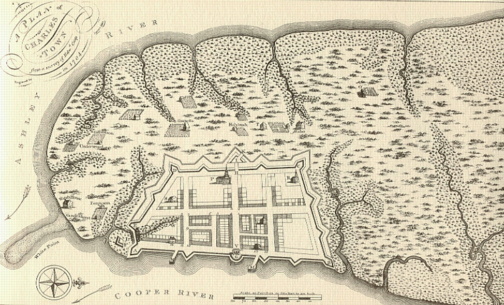A Lowcountry History
Written by Ruth M. Miller
©2020
| Surrounded by coastal plain of sparkling beaches, spacious marshes, and palmetto trees... Set in the center of the Carolina LowCountry, like a single jewel on a golden chain... Welcome to Charleston, South Carolina, city of history, mystery and preservation.
How did this living museum of the American story come to be? To understand Charleston, I invite you back to 1663. Discover King Charles II giving away Carolina, all of the land from Virginia to Florida. The recipients, Eight Lords Proprietors, look upon the property as land developers; the colony is theirs to settle and to profit from. Move on to April 1670. Imagine our site. Giant alligators populate virgin forests draped in Spanish moss. Spy the ship Carolina anchored in our fine harbor. The colonists arrive. Ten years later, settlers move to the peninsula defined by the Ashley and Cooper Rivers. Life for Charles Towne, the oldest permanent English settlement south of Virginia, begins.
Once the means of creating fantastic wealth becomes obvious, the cry for enslaved field labor fosters expansion of the English slave trade. By the early 1700s, Charles Towne’s population is an African majority. With the business of rice, timber and slavery, the most cosmopolitan city of eighteenth century America flourishes financially. Her residents are richer per capita than New York City’s. When the Revolutionary War ends our state capital moves to Columbia, Charles Towne becomes Charleston, and the Palmetto State is born.
Journey into the nineteenth century. Enter South Carolinian John C. Calhoun whose influence cannot be overstated – Secretary of War, Congressman, Senator, Vice President under two presidents, and ardent defender of slavery. His oft quoted words - slavery “is, instead of an evil, a good - a positive good.” Charleston rocks the cradle of secession. In 1860, the Ordinance of Secession is signed here and within six months Confederate troops fire on Fort Sumter. The Civil War begins. Blockaded but unconquered, the city harbors blockade-runners, the war profiteers who supply the Confederacy.
The Civil War is over. The abolition of slavery alters everything. The production of wealth withers. Reconstruction government soon departs and white leaders seize control of city and state. Jim Crow laws are everywhere, segregation rules. As America moves onward and westward, this old city at the edge of the Atlantic, is left at the edge of history. Still inhabited by the descendants of colonial days, black and white, Charleston enters the twentieth century. The city is sultry, decaying, seen by some as a beauty "mellowed by time,” overlooked on the national scene. While the Great Depression bleeds America, we've arrived at 1931. Charlestonians pass the very first preservation ordinance in our country.
Old buildings cannot be demolished, they are recycled. Ever so slowly prosperity returns. Then, almost overnight, it is the twenty-first century. From now on, this gem of a city is protected, polished and put on display. You are invited to join us on a present-day adventure into the past. Our living museum of the American story awaits your arrival…. You are welcome to print and publish this history for nonprofit purposes as long as it carries copyright notice: ©2020 Ruth M. Miller |
You are welcome to print and publish this history for nonprofit purposes as long as it carries
copyright notice 2020 Ruth M. Miller
